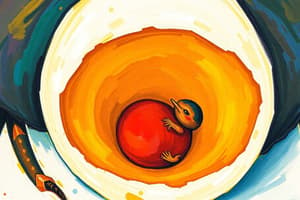Podcast
Questions and Answers
What is the main component of the outer eggshell?
What is the main component of the outer eggshell?
- Calcium phosphate
- Keratin
- Protein
- Calcium carbonate (correct)
What percentage of the edible portion of an egg is protein?
What percentage of the edible portion of an egg is protein?
- 20%
- 30%
- 10%
- 12.6% (correct)
What is the most common protein in egg white?
What is the most common protein in egg white?
- Ovoglobulin
- Ovalbumin (correct)
- Ovomucoid
- Ovotransferrin
What is the function of the two membranes in an egg?
What is the function of the two membranes in an egg?
What is the main difference between the egg yolk and the egg white?
What is the main difference between the egg yolk and the egg white?
What is the percentage of phosphorus in Phosvitin?
What is the percentage of phosphorus in Phosvitin?
What is the purpose of fermentation in the production of egg white powder?
What is the purpose of fermentation in the production of egg white powder?
What is the final step in the production of egg white powder?
What is the final step in the production of egg white powder?
What is the advantage of using egg white powder?
What is the advantage of using egg white powder?
How many disulfide bonds are present in Ovomucoid?
How many disulfide bonds are present in Ovomucoid?
Flashcards are hidden until you start studying
Study Notes
Egg Structure
- An egg consists of three main parts: shell, egg white, and egg yolk.
- The outer eggshell is primarily made of calcium carbonate (CaCO3).
- The two membranes are made partly of keratin and provide defense against bacterial invasion.
Egg White (Albumen)
- The inner thick white (chalaziferous layer) is a dense, matted layer.
- Egg white contains about 90% water and 10% protein.
- It consists of several proteins, including ovalbumin, ovotransferrin, ovomucoid, and ovoglobulin.
Egg Yolk
- The yolk contains less water and protein than the white, some fat, and most of the vitamins.
- The major proteins in egg yolk are lipoproteins, including livetin, lipovitellin, and phosvitin.
Protein Content of an Egg
- Protein content of an egg accounts for about 12.6% by weight of the edible portion.
- Egg contains all essential amino acids, including leucine.
Types of Proteins
- Ovalbumin: an almost spherical glycophosphoprotein, the most common protein in egg white.
- Ovotransferrin: composed of 686 amino acids, consists of 2 forms without phosphorus or sulfur.
- Ovomucoid: a glycoprotein with 9 disulphide bonds, having a stable spatial structure.
- Phosvitin: a phosphoprotein with about 10% phosphorus, containing iron and calcium.
Production of Egg White Powder
- Powdered egg whites are dehydrated and ground into a powder.
- The production process involves breaking, filtering, separating, storing, and spray drying.
Advantages of Egg White Powder
- Can be stored and transported at room temperature.
- Has a good shelf life and is time-saving.
- Can be easily reconstituted with water to make a liquid egg white.
Studying That Suits You
Use AI to generate personalized quizzes and flashcards to suit your learning preferences.



